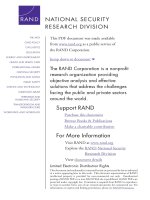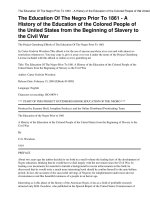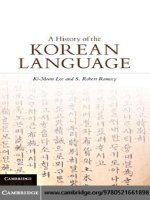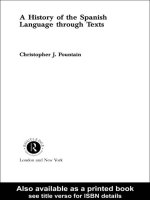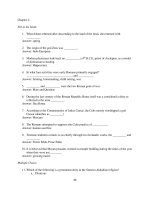Andrew wheatcroft infidels a history of the con lam (v5 0)
Bạn đang xem bản rút gọn của tài liệu. Xem và tải ngay bản đầy đủ của tài liệu tại đây (3.03 MB, 400 trang )
ALSO BY ANDREW WHEATCROFT
The Ottomans: Dissolving Images
The Habsburgs: Embodying Empire
The World Atlas of Revolutions
The Road to War (with Richard Overy)
Zones of Conflict: An Atlas of Future Wars (with John Keegan)
Who’s Who in Military History: From 1453 to the Present Day (with John Keegan)
Copyright © 2003, 2004 Andrew Wheatcroft
All rights reserved under International and Pan-American Copyright Conventions. Published in the United States by
Random House, an imprint of The Random House Publishing Group, a division of Random House, Inc., New York.
This work was originally published in the U.K. by Viking, an imprint of Penguin Books, in 2003.
RANDOM HOUSE and colophon are registered trademarks of Random House, Inc.
Grateful acknowledgment is made for permission to reproduce an extract from “Lepanto” by G. K. Chesterton. Reprinted
by permission of A. P. Watt, on behalf of the Royal Literary Fund.
LIBRARY OF CONGRESS CATALOGING-IN-PUBLICATION DATA
Wheatcroft, Andrew.
Infidels : a history of the conflict between Christendom and
Islam / Andrew Wheatcroft.
p. cm.
Originally published: London : Viking, 2003.
eISBN: 978-1-58836-390-9
1. Islam—Relations—Christianity. 2. Christianity and other
religions—Islam. 3. Kufr (Islam) I. Title.
BP172.W52 2004
261.2′7′09—dc22
2003070378
Random House website address: www.atrandom.com
v3.1
For
ERIC OSCAR WHEATCROFT
in love and gratitude
History is the most dangerous product ever concocted by the chemistry of the
intellect. It causes dreams, inebriates nations, saddles them with false
memories … keeps their old sores running, torments them when they are not at
rest, and induces in them megalomania and the mania of persecution.
PAUL VALÉRY
Reflections on the World Today
Contents
Cover
Other Books by This Author
Title Page
Copyright
Dedication
Epigraph
Acknowledgments
Editorial Note
Maps
Preface
PART ONE
CHAPTER 1
CHAPTER 2
“We Praise Thee, O God”: Lepanto, 1571
First Contact
PART TWO
CHAPTER 3
CHAPTER 4
CHAPTER 5
CHAPTER 6
Al-Andalus
“The Jewel of the World”
Eternal Spain
“Vile Weeds”: Malas Hierbas
PART THREE
CHAPTER 7
CHAPTER 8
To the Holy Land
Conquest and Reconquest
PART FOUR
CHAPTER 9
Balkan Ghosts?
CHAPTER 10
CHAPTER 11
Learning to Hate
“A Broad Line of Blood”
PART FIVE
CHAPTER 12
CHAPTER 13
“Turban’d and Scimitar’d”
The Black Art
CHAPTER 14
Maledicta: Words of Hate
CONCLUSION
CHAPTER 15
The Better Angels of Our Nature
Notes on the Text
Sources and Select Bibliography
About the Author
Acknowledgments
helped me understand the In dels
conundrum. With many, like Hassan and Mahmud, who appear in the preface, I do not
know their full names. Chance has also played a large part. Often it was an unexpected
and anonymous conversation in Amman or Texas that propelled me in a new (and
pro table) direction. But I am particularly grateful to some I can name. First, those who
have undertaken the thankless task of reading part (or all) of the text and putting me
right. Dejan Jović has been kind enough to read through my chapters on the Balkans,
suggesting many changes and improvements, and has not scorned my temerity (and
ignorance) in trampling around in a eld where I had so shallow a knowledge. Part of
my newfound passion for southeastern Europe stemmed from the excellent “Creating the
Other” conference at the University of Minnesota (Minneapolis). Organized by the
Center for Austrian Studies in May 1999, it had many Balkan tensions bubbling away
below the surface. Yet we talked as dispassionately as possible about tragic events. With
this book, likewise, detaching my own feelings from the subject matter that I was
writing about has not always been easy.
Another area that I entered with very little prior knowledge was the role of language.
Lance Butler has read every word, not just the material on language, and his advice and
support have been invaluable. So too have Susanne Peters’s help and advice. She has
also read every chapter, sometimes in several variants. She provided me with a stream
of books and articles to read, found many unusual and unexpected sources, as well as
giving me consistent encouragement. Judy Delin explained complicated ideas in
linguistics with such clarity that I could understand them, plus the directness to tell me
when I should not use them. Michael Rice invariably gave me good advice on the texts I
sent him, from his profound knowledge of many areas of the Middle East. Finally, my
father, E. Oscar Wheatcroft, has read it all, an especial labor of love given his failing
eyesight. Thankfully, his critical sense is still hyperactive and he saved me from many
errors, such as having my galleys rowing in reverse, the result of landlubberly
ignorance. None of them bear any responsibility for the flaws that remain.
I have also made myself a nuisance to many others with naïve questions that they
answered with good grace. John Drakakis, Neil Keeble, Robert Miles, David Bebbington,
Mark Nixon, Oron Jo e, in particular, must have dreaded my appearing round the
corner at Stirling. This is also the rst book I have completed with the full availability of
e-mail and the Internet. While my colleagues have had some reason for answering my
questions, those thousands of miles away who had never heard of me had no reason to
do so. I am thankful for the help and advice of Carter Vaughn Findley, Jonathan Bloom,
Dan Go man, Robert Michaels, Larry Wol , David Nirenberg, and Eva Levin. Others,
like Stephen Greenblatt, Roger Chartier, Thomas Emmert, Hugh Agnew, Margaret
THESE PAGES RECORD MY THANKS TO SOME OF THOSE WHO HAVE
Meserve, Nancy Wing eld, and Maiken Umbach, have had the misfortune to be pinned
to a wall over a conference co ee break or interrogated over dinner. From John
Keegan, I have understood, over so many years, to try and see things with clarity,
regardless of the “fog of battle.” It was John who suggested my rst book, so my
gratitude extends back a very long way. From Colin and Charlotte Franklin, I learned
the importance of feeling and touching books, and amid the riches of their “book barns”
at Culham, learned well. Two people have helped me with research for this book, where
either I did not have the time or the languages. Lina Barouch (whom Avi Shlaim
shrewdly suggested) helped me enormously by assessing Hebrew material, reading the
text, and advising me on it. She has a wonderful eye both for things that don’t work and
for the inspired suggestion of something that might work. Anneyce Wheatcroft has never
complained about being asked to burrow in the darker and dirtier parts of libraries and
archives on my behalf. She too has the instinctive sense for unlikely but invaluable
material. I am very grateful to them both.
I am very grateful to all those who have helped me by pointing out mistakes in the
rst printing of this book, in May 2003. Rana Kabbani, Jonathan Falla, Jonathan
Benthall, and John Adamson have all been kind enough not only to remind me of
literals, but also to suggest where another interpretation was better than the one I had
o ered. I have been very happy to adopt their suggestions, and thank them both for
their courtesy and their careful reading. Carol Buchalter Stapp spent hours patiently
disentangling the complex issues in the last chapter: her insights have been invaluable. I
also want to thank John Torpey, who has generously responded to all my questions and
uncertainties concerning the same endlessly revised and updated chapter.
Writing a book like this, which ranges over so many disparate areas and subjects,
makes a real imposition on your friends. Rosemarie Morgan bore the brunt of the rst
phases. She smoothed access at Yale, provided endless hospitality, and employed an
incisive critical pencil. Without her help, this book would have been much harder to
write. John Brewer and Stella Tillyard have been the best friends (and hosts) anyone
could have, in Florence and in Oxford. They have also contributed more to this book,
from what they have written, from conversations, or from chance asides, than they
could ever have realized. So too have Fuad Qushair in Amman, with whom I roamed
over deep questions concerning the Arab world and the Arabic language; Mamdouh Anis
and Christian Koch in Abu Dhabi, from whom I learned how to keep a book on track. In
England I am grateful to David Batson, with his knowledge of the early church; Richard
Stoneman, for his expert knowledge of Greece and Turkey; Geo rey Best, for his
friendship over many years; and Roy Douglas, who helped me to decipher images.
Among many others who have “been there” with advice, help, or company when I
needed it, I want to mention in particular Mohammad Cherki and Dja ar Hadji, who
introduced me to the new literature of Algeria; Angelica Hamilton, whose constant
verve and enthusiasm stopped me doubting the whole enterprise; Nagdi Madbouli, on
whom I tested Arabic meanings; Andrew Sobić and Alec Stanković, with whom I talked
endlessly about the Balkans; and nally Freddie Merle and Charlie Seddon, the good
companions.
In Granada, many years ago, Don Jésus Bermudez Pareja and Srta. Angelina Morena
allowed me to roam in the archives of the Alhambra, and gave me introductions to the
other archives in the city. Through them also I found my way into the mountains, to the
Alpujarras, the last redoubt of the Moriscos. Those experiences have colored my life and
career ever since.
Two museums were invaluable for the part of the book that deals with the printed
word. The rst was the Musée de l’Imprimerie de Lyon, established with the guidance of
Henri-Jean Martin, and the other the Gutenberg Museum, Mainz. Sadly, my visit to the
Plantin-Moretus Museum in Antwerp had to be canceled. These museums were most
helpful to me and they o er a unique opportunity to get a clear sense of the world of
print. This is especially true for the rst three centuries and all the processes that then
went into the making of books.
I want to express my continuing gratitude for access to the world of old books through
the Library of Congress and the Folger Library in Washington, D.C.; the Sterling,
Beinecke, and Seeley G. Mudd libraries at Yale; and the Wilson Library at the University
of Minnesota. Also the University Library at Texas Tech University, where I have
worked happily over a number of years. Closer to home much of my work has been
done in the British Library, with the book collections at the Victoria and Albert Museum
and in the School of Oriental and African Studies in London; at the National Library of
Scotland in Edinburgh; in the Library of Trinity College, Dublin, and the Library of the
University of Leeds. Cambridge University Library, the Library of the Warburg Institute,
and the Special Collections of the University of Edinburgh Library have been invaluable
sources of material.
In Vienna, the Österreichische Nationalbibliothek proved a treasure trove for the early
images of the in dels. I have also had the bene t of using the resources of ENSSIB in
Lyon. On other visits I have bene ted from IRCICA in Istanbul, and the Darat al Funun,
Amman, Jordan. But I have two special debts that should be acknowledged. The rst is
to Dr. Jamal S. Al-Suwaidi, who invited me to work at the Emirates Center for Strategic
Studies and Research (ECSSR) on a number of occasions over a period of four years. I
bene ted a great deal not only from using their excellent library, but also from Jamal
Al-Suwaidi’s advice and interest in my work. The second is closer to home, in Stirling.
Not only has the university given me generous sabbatical leave, but the work of the sta
in the library at Stirling has been far above the call of duty. I think I hold the university
record for interlibrary loans. This has meant that with a topic covering so many
di erent areas and languages, I have been able to spend the time reading and writing
that I had previously spent in traveling. This library cannot compare in the size of its
holdings with larger institutions, but what it stocks has been well chosen. And there
were many surprises. When a much larger library did not have the mid-nineteenthcentury volumes of Punch that I needed, I found them sitting on the shelf at Stirling.
I am especially grateful to my editor, Eleo Gordon, on two particular grounds. First,
she accepted that, while delivery kept on slipping, I was in fact working hard on the
book. Second, as with my two previous books for Viking, every editorial suggestion she
has made has been delivered with such tact that it was easy to accept. And in every
case, her judgment has been incisive and absolutely right. I am especially grateful, too,
for Elisabeth Merriman’s patient and painstaking editing of the text. Her suggestions for
rephrasing, clari cation, or additions have almost invariably been an improvement; I
have adopted them readily and with gratitude.
The nal part of the book is di erent in this edition from the text I completed in the
summer of 2002. Connecting the present to the immediate past has proved much more
complex than I had rst imagined. So I am immensely grateful to Will Murphy, senior
editor at Random House, who courteously but decisively stripped away redundancies,
byways, and authorial meandering. The responsibility for the book is entirely mine, but
it has gained a great deal from working with a fine, creative editor.
There is a penultimate acknowledgment that I must make. I knew Lawrence Stone for
over twenty years, for some of that time in the ambiguous role of his “commissioning
editor.” Being Lawrence’s editor was a wholly one-way process. He wrote and his editor
merely organized the book for publication. It was not that he would not take advice,
which he did, but it was rarely needed. In the reverse process, seeking his advice for my
own work, it was a very di erent matter. Lawrence contributed a great deal. We met
annually, either in Oxford or in Princeton. He made suggestions, provided contacts, was
a rigorous critic of my musings, but always encouraged me to continue. Lawrence was a
wonderfully supportive friend, and had I written a little faster and followed fewer of the
byways that Lawrence so actively endorsed, he might have seen this book before his
untimely death.
My last and greatest thanks are due to my wife, Janet Wheatcroft. She has su ered
from more than ten years of my worrying preoccupation with this dark topic, read
drafts that are too many to count, and gently edged me away from the wildest
extremities. But she has also measured what I have written against her own experience
of living an essentially medieval life, solitary, in another culture, with no roads, without
electricity, telephone, and lacking a common language. She lived by her wits and the
loving-kindness of those around her. They could not understand why she was there, but
they accepted her presence. That was in Nepal, not a Muslim culture, but that made
little di erence. She was a silent observer, seeing Sherpa family and village life and
relating it to her own experience. What I could only sense about the past, about
similarity and di erence, she could gauge against what she had seen and felt. Without
the bene t of her insight gained over those many months, painfully lonely for both of
us, I should never have been able to complete this book.
Editorial Note
. “West” and “East,” “Europe,”
“Mediterranean Islam,” “Christendom” are all terms that I have used regularly, while
recognizing that they will o end purists. Likewise I have been very chary about using
now commonplace, heavily charged terms like “the Other,” “Orientalism,” or
“fundamentalism,” and on the whole avoided all three.
Place-names and proper names always pose a problem, especially in this book, where
the names themselves can be a source of bloody dispute. The general rule has been to
use the form most recognizable to the English-speaking reader, but even that is not
wholly systematic. The normal English version for Islam’s holy text is “Koran,” but I
have habitually written “Qur’an.” There are other similar instances.
I have also faced a dilemma. Many images are mentioned in this text, many more
than are actually illustrated. Where I have not shown a visual image that is signi cant
for the argument, I have described its content in detail. But one of the problems of using
pictures is that they now come at a high cost. Ideally, I would have liked to use many
more. But for those readers who, like Doubting Thomas, need to see for themselves, I
can only answer mea culpa.
For using the word “in del,” however, I make no apology. For convenience I have
taken the European, Latinate word “in del,” both for the way that the Christians
referred to Muslims and as the equivalent for the Arabic kafir, which was how the
Islamic world regarded the Christians. Other words were used, but the category—those
without the bene t of the true faith, Islam for one world, Christianity for the other—was
roughly symmetrical. That suggestion of a mirror image, and its consequences,
underpins what follows herein.
PROBLEMS
OF
TERMINOLOGY
ARE
INHERENT
IN
A
BOOK
LIKE
THIS
Preface
, alone and fearful. Two men in an ancient
little truck stopped and asked, rst in Arabic and then in French, where I was going. I
told them, north, to Tangier, and then to Spain. As we drove, very slowly, we talked in
a desultory way, but most of the journey was silent. But when we got to the city, they
insisted that I stay with them.
These two brothers took me to their home, where I stayed for several days. They
showed me the low life of the city, which was extensive, and we spent (it seemed) many
hours in the suq, drinking Moroccan mint tea, for which I have never lost the taste. At
night the power invariably failed, leaving the center of Tangier in darkness. The hubbub
would stop for a few seconds, and then lights and candles would be lit, people shifting
e ortlessly from a modern to a more traditional pattern of life. Eventually, and with
some reluctance, I said that I had to catch the boat to Malaga, and undertake another
long walk to Granada. My new friends, Hassan and Mahmud, took me to the port and I
left. I never saw them again, but that is where this book began.
This is the kind of experience that many travelers, men and women, have had. Later
on the road I heard of people who had been robbed or held up in Morocco. From the
stories I could tell that while some accounts were obviously true, others stemmed from
some instinctive suspicion and from the consequent misinterpretation of a friendly
gesture that can arise between “East” and “West.” At the time I said nothing, thinking
how foolhardy I had been. But subsequently I understood not just the hospitality of my
two chance friends but also the risk that they had taken, picking up someone who might
claim that they had stolen from him, or worse. This had not stopped them. Hassan and
Mahmud saw only someone tired and thirsty.
The fear was real and so too was the friendship. Over the succeeding years
researching in Spain and the Middle East, I read more and more about the deep
antipathy between Islam and the Western world, about the violence and hatred that it
generated. But as the pile of material grew, the clarity of this image diminished. So too
did the connection between cause and e ect. Often some occurrence, a massacre or
some other act of violence, was rooted in particular events, but as often the trail petered
out. The rationale just lay somewhere in the undi erentiated past. It was a given: the
two worlds (“East” and “West” or, more accurately, “north” and “south,” at all events
“Christendom” and “Islam”) were in opposition to each other. There were connections
even longer in duration, such as the relationship between the Christian and the Jewish
worlds, that often generated atrocity. But it was not the same. There was something
quite speci c in the meeting between Islam and Christendom that seemed to engender
violence. The deep cause seemed hidden beneath the normal explanations, underlying
political and economic rivalries, personal ambitions and vanities, chance and accident.
I REMEMBER SITTING BESIDE A ROAD IN THE MIDDLE OF MOROCCO
As a child I used to play a game called Chinese Whispers. There is a story from the
First World War of a message being whispered down a trench, Send reinforcements, we’re
going to advance, and emerging at the end of the long line of soldiers as Send three and
fourpence, we’re going to a dance. In communications theory this would be an example of
interference and dissonance. In our playground games, you passed on what you heard,
never intentionally changing it (however absurd) before you whispered it to your pal.
We never said to the next in line that the message seemed meaningless or stupid—at
most we raised an eyebrow, but we repeated what we thought we had heard. The
meaning obviously changed as the phrase traveled from person to person, but no one
was consciously responsible for the distortion.
This aleatoric, or unintended, consequence is implicit in any act of communication.
When Pope Urban II stood outside the cathedral of Clermont in 1095 and called for
Christians to rescue Jerusalem, he did not have “the Crusades” in mind. He launched an
idea to the winds, trusting to the grace of God. But Urban had no control over the effects
of his words. They echoed and resonated for centuries long after his own death.1 This is
the history of non-ideas, of Chinese Whispers. Yet the consequences in human terms of
these fuzzy messages are fearsome. This book tries to trace a few of the myriad ways in
which the Christian West has responded to the Islamic East. But even talking about the
task is complicated. Words such as “West,” “East,” “Christendom,” “Europe,” “Islam” are
so strongly contested that it is hard to get beyond them. Typing any of them felt
uncomfortable, for I was only too aware that they could (and would) be misinterpreted.
Since Edward Said eviscerated “Orientalism,” no one can write on these topics with
insouciance. These are now, indeed, things of which we cannot speak with any
confidence.2 For me the way through has been to focus on how hatred was
communicated, rather than pursuing the why of insult and abuse.
This book covers a huge sweep, of both time and place. It begins in the seventh
century and extends into the twenty- rst. Its boundaries are Tamanarasset in Algeria to
the south, and Vienna to the north, the Atlantic to the west, and the Arabian Sea and the
Indian Ocean to the east. Occasionally, it strays outside those limits, but its center is the
world connected with the Mediterranean. That is where I begin. Part One starts with the
galley battle at Lepanto o the shores of Greece in 1571. At the time, many thought it
the transforming moment in an already age-old con ict. It was not, and I go back to the
rst point of con ict—in Palestine nine centuries before. Parts Two, Three, and Four
take, in turn, three areas—Spain, the Levant, and the Balkans—where Christianity and
Islam existed side by side over a long period. Spain takes priority and pride of place.
Perhaps the reason is that I understand that land better than the eastern Mediterranean
or southeastern Europe. But while the story of the Crusades is well known, and recent
tragic events have played a bright light upon the Balkans, Spain’s history “of the Moors”
remains in the shadows. Yet much of what happened in Spain had its echoes and
connections elsewhere along the shores of the Mediterranean.
I am very conscious that a volume as long as this (or longer) could be written on each
of those areas, and still not tell the whole story. This book follows a single thread—the
antagonism between the Western Christian and the Mediterranean Islamic worlds, and
even then I have space to consider only one aspect of the story. In Part Five I suggest
how antagonism was spread, and how it has lasted into the present.
There are other powerful terrors about which I could have written. Western fears of
people with dark skins, or malign prejudices in the West extending to half the human
race, that is, women, both tempted me. These too, like the fear of Islam, have altered
over the centuries but have not been eradicated by enlightenment. Moreover, they
appear here, weaving in and out of the long antagonism to Islam. But at least with
Islam, there was a starting point, a chronology, that gives some shape to the story.
Events, like the storming of Jerusalem in 1099, the capture of Constantinople in 1453,
the surrender of Granada in 1492, the battle of Lepanto in 1571, and the obliteration of
the Twin Towers in 2001, have a visible consequence. We can read them and see how
they made an impact on the human imagination.
Part of the how lies in the structures and mechanisms of language itself. A major part
of language is communication by the human voice. Another part lies in the qualities of
physical texts, handwritten or printed. Images, on the page or on the screen, are
another form of language, whose rules are completely di erent from the spoken or the
written word. The transmission of misunderstanding has in the past involved a mixture
of all three. Now, with lm and television, and the Internet, there is a completely new
recombination of image, sound, speech, and, sometimes, text. It is still mysterious to us.
I have taken only part of this spectrum from a longer history. My story began with the
power of the spoken word and handwritten text in the seventh century and (I had
intended) would end with a world dominated by the printed word and the printed image
on the cusp of the twentieth century. Yet from the moment that my wife called me to the
television to watch the burning towers in New York on September 11, 2001, I sensed
that this was no longer possible. In the days following that catastrophic act of mass
murder, a long-dormant style of public communication was revived. Before that day we
spoke and wrote with one set of assumptions. Afterward, we did things rather
di erently. This is not a value judgment, but simply an observable fact. We had shifted
into a new register.
“Register” describes the sort of talk or writing that is suitable for particular
situations.3 The words that bounce around a locker room are di erent from those you
will hear at a church social. Neither form would be appropriate to the other situation.
Humans are extraordinarily well adjusted to using the correct register for di erent
circumstances. So, faced with an unparalleled situation on September 11, what register
would have been suitable? For an apocalyptic situation, the president of the United
States and his advisers chose an apocalyptic register. This was the end of the world as
they had known it, and a new and darker age had been ushered in. However, this
instinctive dialogic shift did not have quite the results that were intended, nor did each
subsequent attempt to use the new register prove wholly successful. One unexpected
consequence was that it connected directly to the long-dormant memories that form the
subject of this book.
I had just nished the bulk of this book and so recognized other points at which
“apocalypse” had been evoked, either deliberately or by accident. I thought of W. E.
Gladstone in 1876, thundering like an Old Testament prophet at the bestial Turk. I
thought also of Urban II speaking to the huge crowd at Clermont. Words, as Homer says
in the Iliad, have wings.4 With the Internet, e-mail, television, radio, movies, they can
y farther than they could in the days of print alone. Fueling these media with an
ancient apocalyptic discourse can have unforeseen results. The novelist Douglas Adams
told us in his Hitchhiker’s Guide to the Galaxy:
It is of course well known that careless talk costs lives, but the full scale of the
problem is not always appreciated.
For instance, at the very moment that Arthur said “I seem to be having
tremendous di culty with my lifestyle,” a freak wormhole opened up in the fabric
of the space-time continuum and carried his words far far back in time across
almost in nite reaches of space to a distant Galaxy where strange and warlike
beings [Vl’hurgs and G’Gunvuntt] were poised [in conference] on the brink of
frightful interstellar battle.
… At that very moment the words “I seem to be having tremendous di culty
with my lifestyle” drifted across the conference table.
Unfortunately, in the Vl’hurg tongue this was the most dreadful insult imaginable,
and there was nothing for it but to wage terrible war for centuries.5
From the perspective of 2004 it seems that just such an interminable war (against
evil) may be under way, not in fictional hyperspace but on earth.
long history, it is that words and images
are weapons. Where and what they will kill or wound we cannot know when we
unleash them. Remember the old story: no point in worrying about the bullet that has
your name on it, but be very worried about the one inscribed “to whom it may concern.”
Andrew Wheatcroft, 2002–04
IF THERE IS A MORAL IN THE EVENTS THAT I HAVE DESCRIBED IN THIS
Part One
CHAPTER ONE
“We Praise Thee, O God”
LEPANTO, 1571
passed through the congested streets of
Naples.1 Embroidered to the pope’s commission, it was the standard of Christendom, to
y from the tallest mast in the eet of the Holy League as it sailed into battle. The
pope’s banner with a huge golden gure of Christ nailed to the cross loomed over the
stocky Spanish soldiers who carried it in procession from the steps of the Church of
Santa Clara. As the blue ag moved through the Neapolitan crowds, an unnatural
stillness gripped all who watched it go by. An hour before, inside the church, the
assembled nobles, o cers, monks, and priests had stood silent and unmoving, all their
eyes on the admiral of the Holy League, Don John of Austria. Arrayed in cloth of gold,
scarlet satin, and white velvet, the young admiral knelt before the altar as the pope’s
representative, Cardinal Granvelle, handed him his sta of o ce and pointed to the
great banner behind him. “Take these emblems,” the cardinal exhorted, “of the Word
made esh, these symbols of the true faith, and may they give thee a glorious victory
over our impious enemy and by thy hand may his pride be laid low.”
Below the cross of Christ were the emblems of the king of Spain and of the Holy
Father, Pope Pius V, with the badge of the Republic of Venice, all linked by a great
golden chain, symbolizing the power of faith that bound them together. From that chain,
in slightly smaller scale, hung the pendant crest of Don John.2 The emblems marked a
brief moment of unity. For the rst time in more than a century, Christendom3 had
combined in force to do battle with the power of “Islam.”4 The war was sancti ed,
waged under the protection of the golden gure of Christ. The pope had declared that
those who fought in this struggle were to be granted the same plenary indulgences as
earlier Crusaders ghting to secure the Holy Sepulchre in Jerusalem. All who died in the
shadow of this battle flag would be spared the worst rigors of purgatory.5
Eight hundred miles to the east a similar, if less public, ceremony had already taken
place. From the treasury of the imperial palace in Constantinople, a bulky bundle
wrapped in silk had been brought from Sultan Selim II to Ali Pasha, admiral of the
Ottoman eet. It also contained a ag, but one colored a vivid green instead of the
lambent Christian blue. Even larger than the banner that Pope Pius V had entrusted to
his commander, this was one of the most potent emblems of Islam. Upon its surface the
ninety-nine names and attributes of God had been embroidered in gold. It was reputed
that these were repeated no less than 28,900 times. The giant Ku c characters were
surrounded and interlaced with endless reiteration of those same names, in a smaller
ON AUGUST 14, 1571, A GIGANTIC SHIP’S PENNANT OF SILK DAMASK


